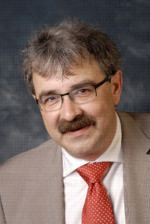Nationality Netherlands Fields Theoretical physics | Name Jan Zaanen | |
 | ||
Born 17 April 1957 (age 68) ( 1957-04-17 ) | ||
String theory in condensed matter physics jan zaanen
Jan Zaanen (born 17 April 1957) is professor of theoretical physics at Leiden University, the Netherlands. He is best known for his contributions to the understanding of the quantum physics of the electrons in strongly correlated material, and in particular high temperature superconductivity. Zaanen's areas of interest are in the search for novel forms of collective quantum phenomena realized in systems build from mundane constituents like electrons, spins, and atoms.
Contents
- String theory in condensed matter physics jan zaanen
- Nachtcollege 2014 jan zaanen over zwarte gaten
- Career
- High temperature superconductivity
- Other areas of involvement
- Recent publications
- References
He introduced the so-called Zaanen-Sawatzky-Allen diagram, the LDA+U band structure method and he became particularly well known for his discovery of the stripe instability of the doped Mott insulator. His present research is focussed on the quantum critical point and unconventional phases of quantum matter. He is also well known for his many editorial contributions to the journals Nature and Science. He is currently on the board of reviewing editors of the latter journal and also editor of the Journal of High Energy Physics.
Nachtcollege 2014 jan zaanen over zwarte gaten
Career
Jan Zaanen was born on 17 April 1957 in Leiden. He received his degree in Chemistry with honours in 1982 at the University of Groningen, where he also received his doctorate four years later, again with honours. He was under supervision with Spinoza prize winner George Sawatzky. After a postdoctoral fellowship at the Max Planck Institute for Solid State Research in Stuttgart, he worked for some years as a researcher at AT&T Bell Laboratories in the USA. In 1993 Zaanen returned to the Netherlands, where he worked at Leiden University as a Royal Netherlands Academy of Arts and Sciences (KNAW) fellow. He has been a professor at Leiden since 2000. Furthermore, in 2004 he was appointed as a visiting professor for one year at Stanford University.
In 2004-2005 he spent a year at Stanford University sponsored by the Fulbright Program and in 2006 he received the Spinoza Prize, the "Dutch Nobel prize", for his scientific accomplishments. Recently Zaanen is one of the driving forces behind the scientific cooperation between the fields of string theory and high-temperature superconductivity. In an interview with Dutch newspaper, De Volkskrant, he stated:
After winning the Spinoza Prize, it was no longer necessary to worry whether I was proving myself enough. You start looking at things you really like. Furthermore I wanted to prove that I was not too old to learn new things. String theory really is another ballgame than the rest of physics] and I'm proud that I was able to learn it.
Zaanen was a visiting professor of Theoretical Physics at the Ecole Normale Superieur, Paris, France. In 2012 and 2013 he respectivaly was a Solvay Professor of Physics at the Solvay Institute, Brussels, Belgium and a fellow of the Newton Centre at the University of Cambridge. At present he is Professor of theoretical physics at Leiden University.
Since 2012 Zaanen is member of the Royal Netherlands Academy of Arts and Sciences.
High-temperature superconductivity
Recently Zaanen is known for his contribution to the understanding of high-temperature superconductivity. In most high-temperature superconductors the copper atoms are arranged in thin layers. Each atom has its own magnetic field which is opposite to that of its neighbor. Electrons can scarcely move in such an environment, as they are also magnetic. Recently, Zaanen and colleagues Cubrovic and Schalm applied String Theory to explain a physical phenomenon. Initially the String Theory attracted a lot of criticism. However, in recent years an increasing amount of experimental evidence has been collected in its favor. Its latest accomplishment is the development of the AdS/CFT correspondence theory, sometimes called Maldacena duality or gauge/gravity duality.
Once it was realised that AdS/CFT could be applied to a broader spectrum of physical phenomena, Zaanen was inspired to use these ideas for his own area of High-temperature superconductivity. Zaanen stated:
"It has always been assumed that once you understand this quantum-critical state, you can also understand high temperature super-conductivity. But, although the experiments produced a lot of information, we hadn't the faintest idea of how to describe this phenomenon. We hadn't expected it to work so well, the maths was a perfect fit; it was superb. When we saw the calculations, at first we could hardly believe it, but it was right."
